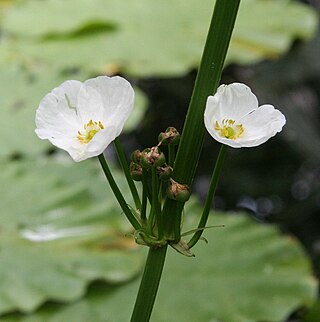
Echinodorus subalatus is a species of aquatic plants in the Alismataceae. It is native to Cuba, Mexico, Central America, Guyana, Venezuela, Bolivia, Brazil and Paraguay. It is found naturally growing in mud by the side of streams.
Tillandsia achyrostachys is a perennial plant in the genus Tillandsia.

Tillandsia juncea is a species of flowering plant in the genus Tillandsia. This species is native to northern South America, Central America, Mexico and the West Indies.
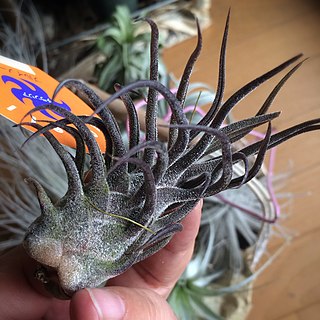
Tillandsia pruinosa, is a species of flowering plant in the family Bromeliaceae. It is commonly known as the fuzzywuzzy airplant. This species is native to northern South America, Central America, southern Mexico, the West Indies and Florida.

Tillandsia stricta is a species in the genus Tillandsia. This species is native to South America and Trinidad.
Billbergia viridiflora is a plant species in the genus Billbergia native to Tabasco, Belize and Guatemala.
Catopsis wawranea is a species in the genus Catopsis. This species is native to Costa Rica, Belize, and Mexico.
Tillandsia × rectifolia is a natural hybrid of T. schiedeana and T. ionantha. This plant is native to Costa Rica and Mexico.

Tillandsia butzii is a species of flowering plant in the genus Tillandsia. This species is native to Costa Rica and Mexico.

Tillandsia fasciculata, commonly known as the giant airplant, giant wild pine, or cardinal airplant, is a species of bromeliad that is native to Central America, Mexico, the West Indies, northern South America, and the southeastern United States. Within the United States, this airplant is at risk of extirpation from the Mexican bromeliad weevil, Metamasius callizona. A related plant, Tillandsia utriculata, sometimes called the "wild pine", is endemic to the same areas.
Tillandsia lampropoda is a species of flowering plant in the genus Tillandsia. This species is native to Central America and southern Mexico, from Oaxaca to Panama.
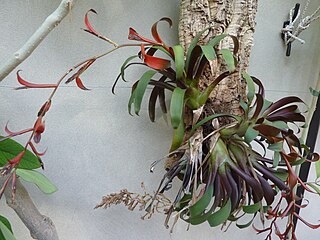
Tillandsia leiboldiana is a species of flowering plant in the genus Tillandsia. This species is native to Central America and Mexico.
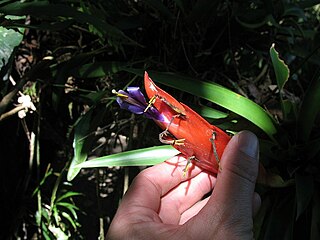
Tillandsia multicaulis is a species of flowering plant in the genus Tillandsia. This species is native to Central America and Mexico.
Tillandsia pseudobaileyi is a species of flowering plant in the genus Tillandsia. This species is native to Mexico, Guatemala, El Salvador, Honduras, and Nicaragua.

Tillandsia punctulata is a species of flowering plant in the genus Tillandsia. This species is native to Central America and Mexico.

Tillandsia schiedeana is a species of flowering plant in the genus Tillandsia. It was named for the collector Christian Julius Wilhelm Schiede. As an epiphyte, it is found "growing in open tropical forests, and saxicolous, growing on cacti and burseras on steep dry slopes in semiarid regions in Mexico, Central America, West Indies, Venezuela, and Colombia at elevations of 750 to 5,500 feet."

Tillandsia streptophylla is a species of flowering plant in the genus Tillandsia. This species is native to Central America, Mexico, and the West Indies.
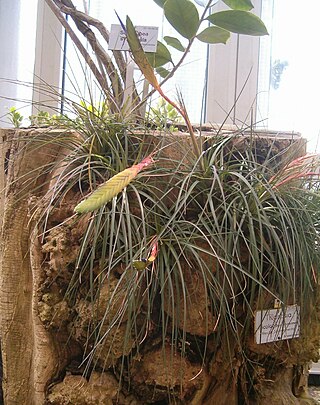
Tillandsia tricolor is a species of flowering plant in the genus Tillandsia. This species is native to Central America and Mexico.
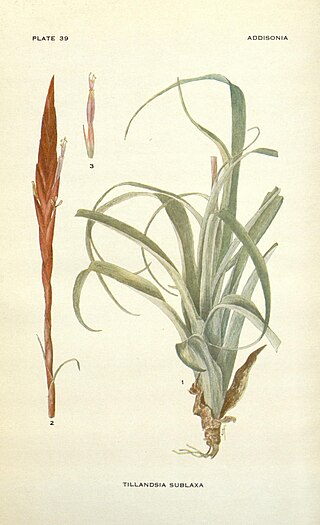
Tillandsia variabilis, the leatherleaf airplant, is a species of bromeliad in the genus Tillandsia. This species is native to Bolivia, Costa Rica, Mexico, Venezuela, Colombia, the West Indies and southern Florida.

Guzmania musaica is a plant species in the genus Guzmania. This species is native to Costa Rica, Panama, Ecuador, Venezuela and Colombia.




















